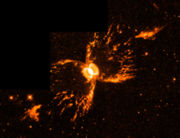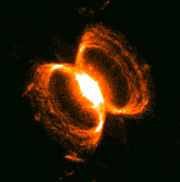
Southern Crab Nebula
Encyclopedia


Nebula
A nebula is an interstellar cloud of dust, hydrogen gas, helium gas and other ionized gases...
located, as seen from Earth, in the constellation Centaurus
Centaurus
Centaurus is a bright constellation in the southern sky. One of the largest constellations, Centaurus was included among the 48 constellations listed by the 2nd century astronomer Ptolemy, and it remains one of the 88 modern constellations.-Stars:...
, but it is actually several thousand light years from our planet. Its central star is a symbiotic Mira variable
Mira variable
Mira variables , named after the star Mira, are a class of pulsating variable stars characterized by very red colors, pulsation periods longer than 100 days, and light amplitudes greater than one magnitude in infrared and 2.5 magnitude in visual...
- white dwarf
White dwarf
A white dwarf, also called a degenerate dwarf, is a small star composed mostly of electron-degenerate matter. They are very dense; a white dwarf's mass is comparable to that of the Sun and its volume is comparable to that of the Earth. Its faint luminosity comes from the emission of stored...
pair.
The adjective "southern" distinguishes it from the Crab Nebula
Crab Nebula
The Crab Nebula is a supernova remnant and pulsar wind nebula in the constellation of Taurus...
, which is in the northern sky. From Earth, it looks like the body and legs of a crab
Crab
True crabs are decapod crustaceans of the infraorder Brachyura, which typically have a very short projecting "tail" , or where the reduced abdomen is entirely hidden under the thorax...
and also somewhat like an hourglass
Hourglass
An hourglass measures the passage of a few minutes or an hour of time. It has two connected vertical glass bulbs allowing a regulated trickle of material from the top to the bottom. Once the top bulb is empty, it can be inverted to begin timing again. The name hourglass comes from historically...
.
The nebula had already been observed using Earth-based telescopes, but images taken with the Hubble Space Telescope
Hubble Space Telescope
The Hubble Space Telescope is a space telescope that was carried into orbit by a Space Shuttle in 1990 and remains in operation. A 2.4 meter aperture telescope in low Earth orbit, Hubble's four main instruments observe in the near ultraviolet, visible, and near infrared...
(shown) in 1999 have provided much more detail, revealing that at the center of the nebula are a pair of stars, a red giant
Red giant
A red giant is a luminous giant star of low or intermediate mass in a late phase of stellar evolution. The outer atmosphere is inflated and tenuous, making the radius immense and the surface temperature low, somewhere from 5,000 K and lower...
and a white dwarf
White dwarf
A white dwarf, also called a degenerate dwarf, is a small star composed mostly of electron-degenerate matter. They are very dense; a white dwarf's mass is comparable to that of the Sun and its volume is comparable to that of the Earth. Its faint luminosity comes from the emission of stored...
.

